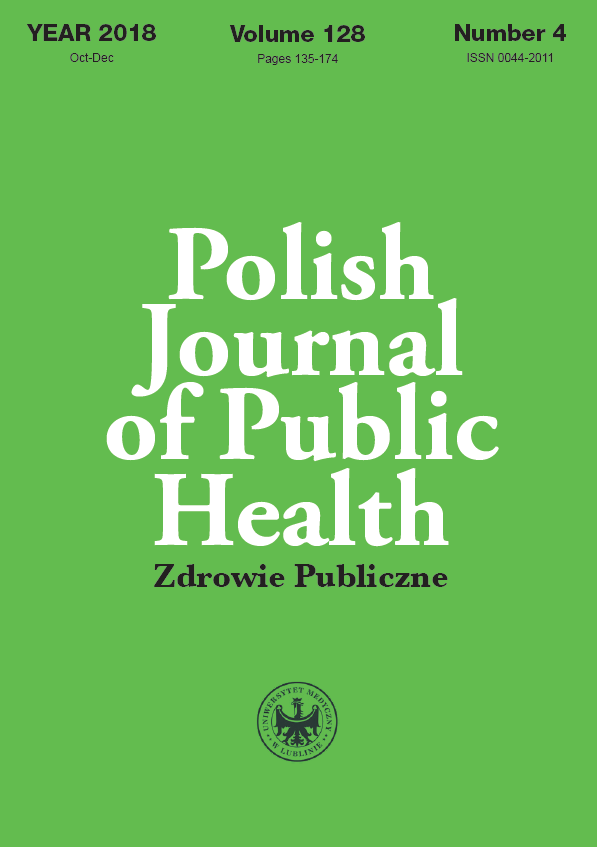Current status and new approaches in prostate cancer diagnosis
DOI:
https://doi.org/10.2478/pjph-2018-0033Keywords:
prostate cancer, prostate-specific antigen, new diagnostic methods, survivinAbstract
Prostate adenocarcinoma, remaining among top most common cancers, is a heterogeneous group of tumors with a diverse morphological structure. Basing on the histological architecture of cancer tissue, individual cases can be classified into different therapeutic groups. Current diagnosis of prostate cancer brings many challenges. The major problem is the lack of effective and accessible diagnostic methods that would eliminate incidences of overdiagnosis and prevent unnecessary treatments of many patients. There are many efforts to determine favorable and unfavorable molecular prognostic factors. The basic marker currently used in this field is prostate-specific antigen (PSA). Increased level of PSA may suggest the presence of prostate cancer although its level is not specific for the disease and can be elevated also in certain benign hyperplastic or inflammatory conditions as well as after irritation or rectal examination. Clinical symptoms such as dysuria or hematuria are often uncharacteristic and benign prostatic diseases which cannot be confirmed on the basis of physical examination alone. Also, we often deal with the situation of false negative results of prostate needle biopsy, which require many tests to determine the final correct diagnosis. Moreover, prostate cancer can also be present in patients with non- elevated serum PSA level. Due to such difficulties, the search for new molecular markers that could be used for diagnostic purposes is underway. Evaluation of survivin level in prostate cancer tissue may serve as a new diagnostic indicator of prostate cancer progression. Other useful molecular biomarkers with good potential in prostate cancer diagnosis are AMACR (Alpha Methyl Acyl Coenzyme A Racemase), p-63 or Ki-67 or microRNAs present in body fluids.
References
1. Witold A. Zatoński, U. Sulkowska, J. Didkowska. Kilka uwag o epidemiologii nowotworów w Polsce. Nowotwory. J Oncol .2015;65(3):179-96.
2. Adams J. The case of scirrhous of the prostate gland with corresponding affliction of the lymphatic glands in the lumbar region and in the pelvis. Lancet. 1853;1:393.
3. Nelen V. Epidemiology of prostate cancer. In: J. Ramon, L. J. Denis (eds). Prostate cancer. Recent results in cancer research. Springer, Berlin, Heidelberg; 2007. p. 175.
4. Pienta KJ, Esper PS. Risk factors for prostate cancer. Ann Intern Med.1993;118:793-803.
5. Tenke P, Horti J, Balint P, Kovacs B. Prostate cancer screening. In: J. Ramon, L. J. Denis (eds). Prostate cancer. Recent results in cancer research. Springer, Berlin, Heidelberg; 2007. p. 175.
6. http://www.erspc.org/news/study-results/
7. Welch HG, Albertsen PC. Prostate cancer diagnosis and treatment after the introduction of prostate-specific antigen screening: 1986-2005. JNCI. 2009;101;19(7):1325-9.
8. Kundra V, Silverman PM, Matin SF, Choi H. Imaging in oncology from the university of Texas M. D. Anderson Cancer Center: diagnosis, staging, and surveillance of prostate cancer. AJR. 2007;189:830-44.
9. Catalona WJ, Richie JP, Ahmann FR, et al. Comparison of digital rectal examination and serum prostate specific antigen in the early detection of prostate cancer: results of a multicenter clinical trial of 6.630 Men. J Urol. 1994;151(5):1283-90.
10. Heidenreich A. EAU Guidelines on Prostate Cancer. Part 1: Screening, diagnosis, and local treatment with curative intent –Update 2013. Eur Urol. 2013;65(1):124-37.
11. Magi-Galluzzi C. Prostate cancer: diagnostic criteria and role of immunohistochemistry. Mod Pathol. 2018;31(S1):S12-21.
12. Bjartell A, Montironi R, Berney DM, Egevad L. Tumour markers in prostate cancer II: diagnostic and prognostic cellular biomarkers. Acta Oncol. 2011;50 (Suppl. 1):76-84.
13. Cuzick J, Thorat MA, Andriole G, et al. Prevention and early detection of prostate cancer. The Lancet Oncol. 2014;15(11):e484-e492.
14. Kosaka N, Iguchi H, Ochiya T. Circulating microRNA in body fluid: a new potential biomarker for cancer diagnosis and prognosis. Cancer Sci. 2010;101:2087-92.
15. Ambrosini G, Adida C, Altieri DC. A novelanti-apoptosis gene, survivin, expressed in cancer and lymphoma. Nat Med. 1997;3:917-21.
16. Okada E, Murai Y, Matsui K, et al. Survivin expression in tumor cell nuclei is predictive of a favorable prognosis in gastric cancer patients. Cancer Lett. 2001;163:109-16
17. Shariat SF, Lotan Y, Saboorian H, et al. Survivin expression is associated with features of biologically aggressive prostate carcinoma. Cancer. 2004;100:751-7.
18. Nakahara T, Takeuchi M, Kinoyama I, et al. YM155, a novel small-molecule survivin suppressant, induces regression of established human hormone-refractory prostate tumor xenografts. Cancer Res. 2007;67:8014-21.
Downloads
Published
Issue
Section
License
Copyright (c) 2019 Polish Journal of Public Health

This work is licensed under a Creative Commons Attribution-NonCommercial-NoDerivatives 3.0 Unported License.


